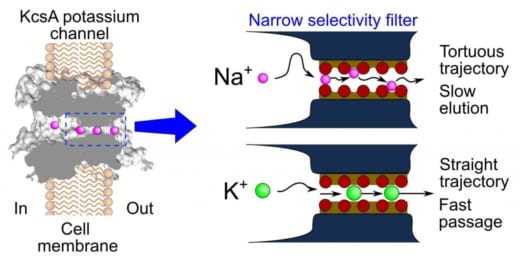New Study Challenges “Established” Mechanism About Selectivity of Cellular Ion Channels
The study demonstrates the passage of sodium ions through a potassium ion channel, indicating that they are not as selective as previously thought
Ion selectivity is an important property of cell membrane ion channels. For example, potassium ion channels are more permeable to potassium ions than to sodium ions. The mechanism underlying the ready passage of larger potassium ions compared to the smaller sodium ions remains elusive. In a new study, scientists show that potassium channels are not as selective as thought. The study demonstrates, for the first time, that sodium ions can traverse potassium channels, albeit slowly.
The cell membranes of all organisms contain ion channels that permit ions to pass into or out of the cell, and these channels play extremely important roles in fundamental physiological processes such as heartbeats and the rapid conduction of signals along neurons. An important property of these ion channels is their selective conductivity—they selectively permit the passage of particular ions. For example, potassium channels more readily permit the passage of potassium ions than the passage of sodium ions, despite the fact that potassium ions are larger.
Presently, the mechanisms underlying the high selectivity of cellular ion channels remain unclear. According to Professor Shigetoshi Oiki of the University of Fukui, “Ion selectivity poses a fundamental question for understanding the workings of channel proteins”. Now, thanks to the joint efforts by a team of researchers from the University of Fukui and Kanazawa University, led by Prof. Oiki, the scientific community is a step closer to understanding those mechanisms. In a study that is soon to be published in the prestigious journal Proceedings of the National Academy of Sciences of the United States of America, the scientists provide groundbreaking insights into the passage of sodium ions through potassium channels. Their results challenge the long-held assumption of the strict selectivity of potassium ion channels, and may even bring about changes to the basic scientific concepts taught at the college level!
To gain empirical insights into the passage of sodium ions through potassium ion channels, the investigators conducted experiments with an artificial cell membrane which contained a type of potassium ion channel called KcsA that allows intracellular potassium ions to exit the cell. By analyzing the electrical currents through the channel, the investigators confirmed that sodium ions could pass through the channel. Most biology textbooks state that potassium channels are ten thousand times more permeable to potassium ions than to sodium ions, but experimental results demonstrated that the conductance of sodium ions through a single channel was one-eightieth that of potassium ions. This indicates that scientists have drastically overestimated the channel’s selectivity.
The investigators next worked with computer simulations of the KcsA potassium ion channel to gain insights into the mechanism of how potassium and sodium ions moved through the channel. As expected, their models showed that multiple potassium ions could easily traverse the channel together via a straight path. However, in the case of sodium ions, the models revealed a convoluted passage, with sodium ions taking a tortuous and difficult route full of places where they could become temporarily trapped and eluting out very slowly. These simulation results help to explain why potassium ions traverse the channel a hundred times more easily than sodium ions do.
The team’s findings do more than simply clarify the details of how cell membrane ion channels work. In the words of Prof. Oiki, “We refuted the static assumptions of the strict potassium ion channel selectivity. Our study demonstrated sodium ion permeation through a potassium ion channel and its atomistic mechanism for the first time”. Furthermore, the team’s findings may even have important implications for medical research owing to the existence of ion channel disorders, also known as “channelopathies,” that affect millions of people worldwide.
In time, the findings will “channel” research in new and exciting directions, with important ramifications both for our understanding of basic biology and our ability to treat various diseases!
Image
Cell membranes contain channels that selectively permit ions to move into or out of the cell. In a recently published paper, researchers from the University of Fukui and Kanazawa University provide new information that revises the traditional understanding of how selective these channels really are.
Article
- Title
- Conductance Selectivity of Na+ Across the K+ Channel via Na+ Trapped in a Tortuous Trajectory
- Author
- Kenichiro Mita, Takashi Sumikama, Masayuki Iwamoto, Yuka Matsuki,Kenji Shigemi, Shigetoshi Oiki.
- Journal
- Proceedings of the National Academy of Sciences of the United States of America
- Publication date
- Mar 23, 2021
- DOI
- doi.org/10.1073/pnas.2017168118
- URL
- http://doi.org/10.1073/pnas.2017168118


